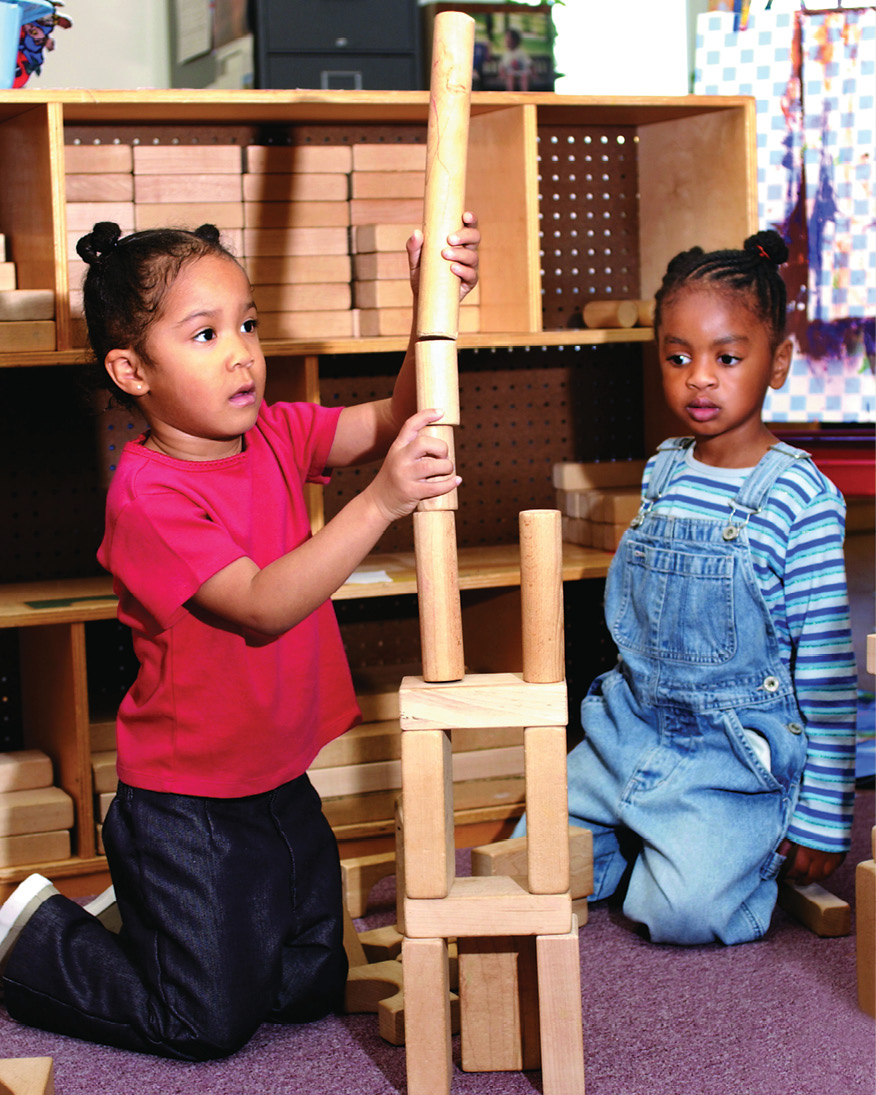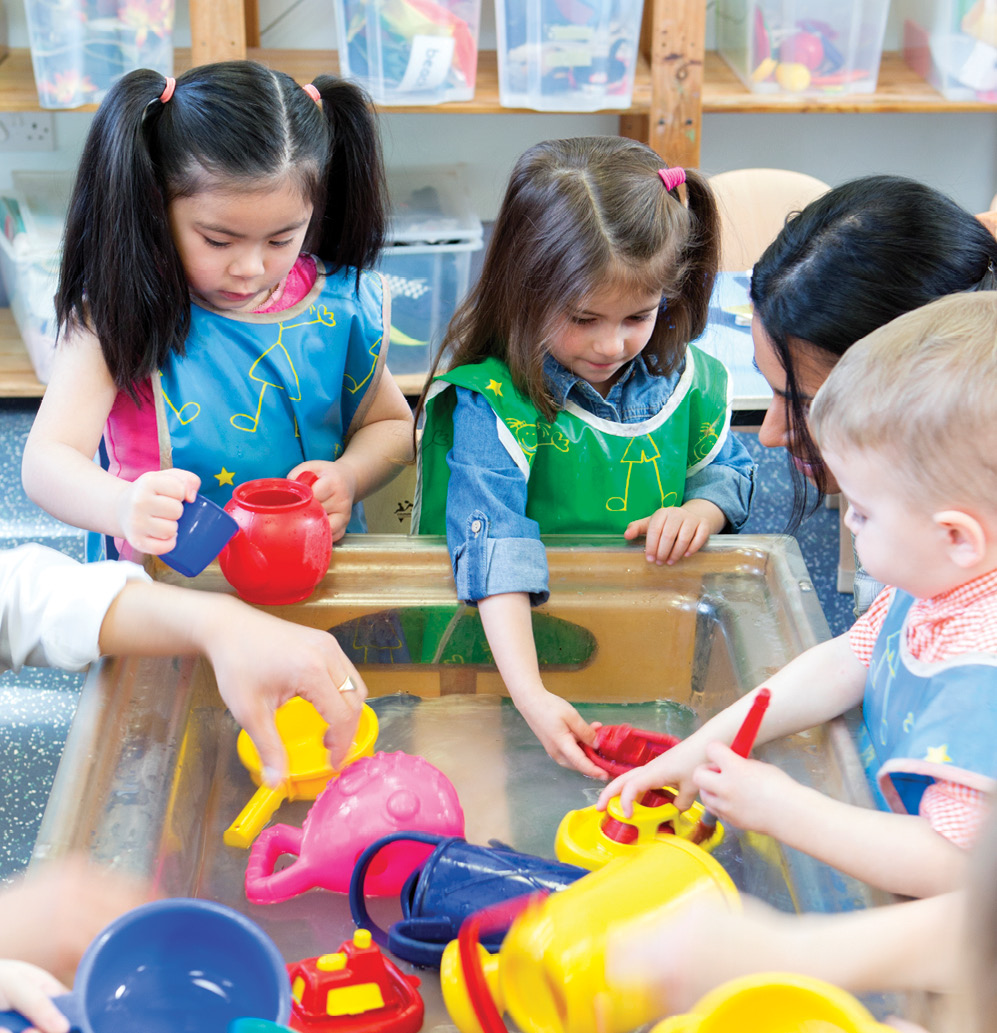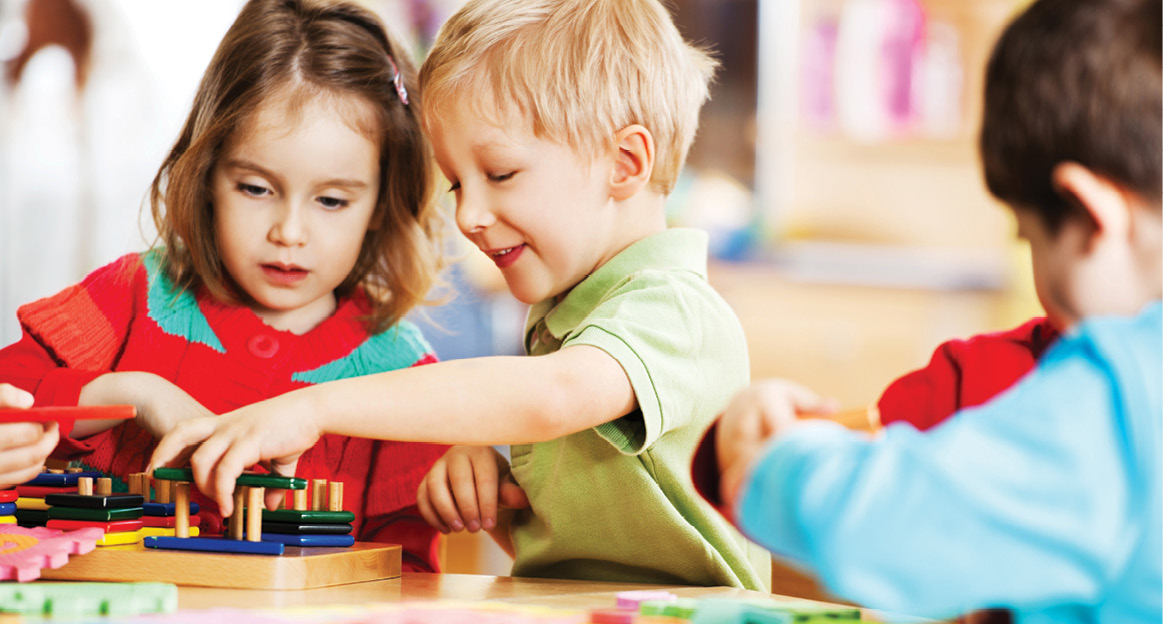Creative Art Activities Should Include Teacherdesigned Step by Step Instructions True False
It is early in the day. Kris, one of my 22 kindergartners, is sharing her periodical entry and drawing with me. Afterwards our talk, she walks to the carpeting to play. She observes a group of children who accept discovered that the magnifying glasses we used during this forenoon's math lesson enlarge words constitute throughout the room. She then joins a group that is edifice a house out of blocks, carefully balancing different shapes on top of each other. After nearly thirty minutes, I announce it's time for morn meeting. The class responds with, "Awwww! Can't we go along playing?"
In my kindergarten classroom, I strive to provide an engaging environment where play is the prominent back up for and means of learning. Merely in truth, I find it challenging. Earlier in my career, I used a didacticapproach full of worksheets and drills because it was "expected." While I encounter pocket-size amounts of directly instruction as useful, I as well know that play-based learning is essential for young children. Play encompasses noesis building, problem solving, communicating, and collaborating; yet throughout my career I've oft felt that the field is gently nudging me toward focusing on "skills and drills." Even later on 23 years as a teacher, I feel torn betwixt ensuring the children accomplish sure benchmarks at certain times and offering a more child-centered pedagogy that creates opportunities for exploration.
The current educational emphasis on standards and high-stakes assessments places tremendous pressure on teachers and children, leading to "potentially problematic instruction practices" (NAEYC 2009, iv). Because the long lists of specific objectives that must exist accomplished by the end of the twelvemonth—unremarkably without extended learning time or other additional resource—it is easy to sympathise why teachers would be skeptical about devoting their limited course time to kid-centered approaches to instruction. Child-directed, playful learning is often less efficient than teacher-directed learning; but if nosotros value healthy child development, nosotros must find a remainder in our classrooms (Hassinger-Das, Hirsh-Pasek, & Golinkoff 2017).
The teacher's role
Anna and Lizzy are buying items at the "grocery market," a project the children initiated and constructed after a lesson on community. Grocery items were sorted, discount signs were made, and a checkout area was prepare upwardly with bags and play money. I see an opportunity to introduce coin. I walk over to Carly, the cashier, and ask, "How much are the grapes?" "Ten cents," she replies. I concur out a handful of coins and say, "Can you help me? What coins practise I need for 10 cents?" Anna says, "Look for the one that says 10 cents." "Where do y'all see that?" Lizzy asks. "It'south actually pocket-sized," I reply. "Permit's get the magnifying glass to see information technology."
 Later, we have a form discussion well-nigh the names of the coins and their characteristics, using magnifying glasses as tools. After our chat, the coins and magnifying spectacles are put in the exploration centre, where the children quickly learn that they tin magnify other objects, including impress.
Later, we have a form discussion well-nigh the names of the coins and their characteristics, using magnifying glasses as tools. After our chat, the coins and magnifying spectacles are put in the exploration centre, where the children quickly learn that they tin magnify other objects, including impress.
During play, teachers are researchers, observing children to decide how to extend their learning both in the moment and past planning new play environments. They must figure out how to quietly arbitrate to help children connect contexts to everyday concepts and academic content, leading to further cerebral, social, and emotional development (NAEYC & NCTM [2002] 2010; Fleer 2009). Past strategically expanding play and asking questions that claiming children's thinking, teachers create meaningful learning opportunities to help children draw an understanding between their observations, ideas, and judgments (Blake 2009). A mix of kid-directed and guided play should be incorporated into the day. When the play environment is intentionally created, the learning that occurs is equally deliberate and logical as whatever instructor-directed lesson, nevertheless the activities are offered in a manner that is advisable to the evolution of each child (Leong & Bodrova 2012).
In my classroom, children play every day, only I am never "merely letting children play." I am observing, guiding, and planning.
I watch with curiosity as David and Marco catch a stack of playing cards. They look tentatively at each other, then turn to me, saying, "We're not sure what to play." I evidence them a menu game in which they volition exercise cooperation and further develop their number sense. I explicate the need for a "caller" who distributes the cards and directs the other players when to flip over their summit carte du jour. The histrion holding the card with the highest numerical value wins that round.
Anna walks over and watches. "Would you like to play?" I ask. She smiles and joins in. After we play another round, I alibi myself from the game; the players all concur to vote on who will accept my place equally the caller. Anna is chosen, simply it isn't long earlier I notice Marco throwing his cards on the floor, frustrated that Anna is telling him what to do. I remind the group well-nigh their vote, and they continue playing.
Later, when another kid joins in, the same problem arises—but the children don't need my help. Marco explains that one person needs to be the caller.
This situation reflects my many roles equally a teacher (Synodi 2010). In the get-go, I was anobserver, expecting (based on prior observations) that the two boys would likely need some assistance initiating play. As aninstructional leader, I selected a game that would develop their academic and social abilities. As aparticipant, I modeled a new game and invited some other child to join the group. When the first dispute occurred, I became themediator, emphasizing the agreed-on rules.
During play, teachers are researchers, observing children to decide how to extend their learning.
During play-based learning, teachers are often subtle participants or gentle guides who seek to enrich or expand on the present experience. With the carte du jour game, I was able to reinforce an of import math concept (comparing number values) and support the children's growing abilities to work with others and regulate their feelings.
In this instance, setting fourth dimension aside for play resulted in a teachable moment when David and Marco asked for my help—only such opportunities practice not e'er occur. Every bit a instructor dedicated to providing significant amounts of playtime every twenty-four hour period, I continually inquire myself: How can I extend the play experience that I'yard watching to connect it to the standards I'm required to teach?
From theory to reality
Some may fence that play is an inappropriate means of achieving standards. I take found that children tin run into and exceed standards through playful learning that combines open up-concluded experiences, child-directed initiatives, and teacher-guided activities. Withal, as uncomplicated as play may audio, I volition admit that achieving a balance between accomplishing set curricular goals and sustaining a child-centered environment is more hard than one would think (Ranz-Smith 2007). Through experience, I have learned that in that location are three primary factors I need to address to bring play and standards together: beingness intentional in crafting activities, identifying children's developmental needs, and assessing growth.
Intentionally crafting activities

To accost specific academic standards, I sometimes introduce a concept with a whole-group activity, then plant an surroundings that supports further exploration during free-play time. I consciously determine the purpose and intentionality of all activities (including play), asking myself, "Practise all of the materials and activities have a purpose?" It is the meaningfulness of the activities, as determined by the kid, that creates a springboard for learning through curiosity and exploration (NAEYC & NAECS/SDE 2003).
An example of my endeavour to utilize play equally a primary means of learning is a lesson in which I introduced the concept of sink or float. The weekly theme was Life in the Sea, which prompted a child-directed word nearly boats and why they are able to float in the water. I engaged the children in making boats out of foil and seeing how many dice information technology took to sink their boats. I introduced how density and shape, not size, determine whether an object floats. Subsequently giving a demonstration to the whole group, I made the activity an independent center for the children to explore. I watched every bit they eagerly tried to make boats, which was speedily followed by piling up dice and revising their gunkhole designs. While the beginning of the activity was a grouping demonstration, it motivated the children to explore their own questions independently and to investigate and challenge their assumptions.
I am certain that the children enjoyed, and learned a smashing deal from, this activity—but was this an example of play? If play must exist open concluded, kid selected, and voluntary, play did non happen until subsequently my demonstration. The demonstration, though, sparked the children'southward curiosity.
Identifying developmental needs
I of the greatest yet well-nigh challenging facets of didactics kindergarten is accepting that private development has its own time frame. To honor individual development, teachers do their best to implement activities that are suitable for each child. Play is benign because it allows for more variation than many teacher-directed lessons. With children varying in their current abilities and needs cognitively, socially, emotionally, and physically, having a flexible approach to teaching and learning—including lots of time for costless and guided play—is essential. An illustration of how I apply this understanding is the changes I made to my classroom schedule.
4 children walk over to a puzzle on a table. They try to put the pieces together through random trial and error. Seeing that they have no strategy with which to solve the puzzle, I initiate a conversation on how to utilize the shapes of the lines to connect pieces and how to look for key images to determine the overall picture. Ten minutes afterwards the timer rings to clean upwardly. "But we didn't finish!" they tell me. Realizing the high-quality learning they were engaged in while playing with the puzzle (an activity that the children chose), I tell them we volition take more time later in the day to cease. At luncheon, I rearrange the daily schedule to offering more time for intentional choices and flexibility rather than defined and required work.
Knowing that a developmentally appropriate environment does not mean giving the children full command of the classroom, I focused on designing choices that are agile and engaging. For example, I incorporated math games (including board and bill of fare games) into our morn coming together and restructured recess to allow more time for outdoor exploration (including science investigations). Materials (such as paint, tape, and musical instruments) that I previously brought out only on special occasions, I made available for the children to use at their will during open play every day.
Assessing growth

Overall, my instructional approach is based on my knowledge of children'due south development and effective education practices. Nonetheless, the direction of learning and specific activities are determined by my ongoing observation of the children's interests, abilities, and efforts. For me, assessment includes seeking evidence of children's learning and honestly reflecting on my own do. I regularly ask myself whether I have an effective instructional plan in place and, if so, what I can await the children's growth to wait like.
In kindergarten, teachers employ a variety of evaluation tools, such every bit portfolios, running records, anecdotal notes and narratives, and formal assessments that measure acquisition and awarding of skills and concepts. Equally I take shifted toward play-based learning and created more fourth dimension for child-directed activities, I have carefully observed children's interests, efforts, and growth. Over time, I have found that the combination of observing play and conducting skill-specific assessments provides well-balanced information. Examining both, I am able to determine the management of learning and develop activities that are appropriate, flexible, and challenging, including more free and guided play.
Reflection
In my experience, there are times when trying to brand the bookish standards meaningful while guiding and extending children's interests and curiosity feels similar a walk in the dark. In putting aside the safety of worksheets and trusting in the guidance provided by the children, I detect myself wondering on a daily ground, What did the children gain today from being in my class? Did I miss an opportunity for learning? Did I reinforce the connection betwixt intentionality, developmentally advisable activities, and assessment? Based on my observation, what did they acquire from playing? While my answers are almost e'er much richer than they were when I relied heavily on worksheets, I detect that these questions are essential to my ever-increasing intentionality, and thus to the children's learning.
Playful learning combines open-ended experiences, kid-directed initiatives, and teacher-guided activities.
Although children may not fully sympathise the broader ideas they are exploring while playing, play provides experiences that contribute to their nowadays knowledge and abilities that they will rely on when solving problems in the futurity (NAEYC & NCTM [2002] 2010). Teachers' professional person cognition of kid development directly impacts instruction and the cosmos of an constructive play-based learning environment (NAEYC 2009). When teachers connect bookish standards to play activities, they gratuitous themselves to support the overall evolution of children.
References
Blake, S. 2009. "Engage, Investigate, and Written report: Enhancing the Curriculum with Scientific Inquiry."Young Children64 (6): 49–53.
Fleer, M. 2009. "Understanding the Dialectical Relations between Everyday Concepts and Scientific Concepts inside Play-Based Programs."Research in Science Education39 (ii): 281–306.
Hassinger-Das, B., K. Hirsh-Pasek, & R.M. Golinkoff. 2017. "The Example of Encephalon Science and Guided Play: A Developing Story."Young Children 72 (2): 45–fifty. www.naeyc.org/resource/pubs/yc/may2017/case-brain-scientific discipline-guided-play.
Leong, D.J., & E. Bodrova. 2012. "Assessing and Scaffolding Make-Believe Play."Young Children67 (one): 28–34.
NAEYC (National Association for the Pedagogy of Immature Children). 2009. "Developmentally Appropriate Practice in Early Childhood Programs Serving Children from Birth through Age viii." Position argument. www.naeyc.org/positionstatements/dap.
NAEYC & NAECS/SDE (National Association of Early Childhood Specialists in State Departments of Instruction). 2003. "Early Childhood Curriculum, Assessment, and Program Evaluation: Building an Constructive, Accountable System in Programs for Children Birth through Historic period 8." Joint position statement. www.naeyc.org/files/naeyc/file/positions/pscape.pdf.
NAEYC & NCTM (National Council of Teachers of Mathematics). 2002. Updated 2010. "Early Childhood Mathematics: Promoting Good Beginnings." Joint position statement. www.naeyc.org/files/naeyc/file/positions/psmath.pdf.
Ranz-Smith, D.J. 2007. "Teacher Perception of Play: In Leaving No Child Backside Are Teachers Leaving Babyhood Behind?"Early Education and Evolution18 (2): 271–303.
Synodi, E. 2010. "Play in the Kindergarten: The Case of Norway, Sweden, New Zealand, and Japan."International Journal of Early Years Education 18 (3): 185–200.
Source: https://www.naeyc.org/resources/pubs/yc/mar2018/observing-planning-guiding
0 Response to "Creative Art Activities Should Include Teacherdesigned Step by Step Instructions True False"
Post a Comment